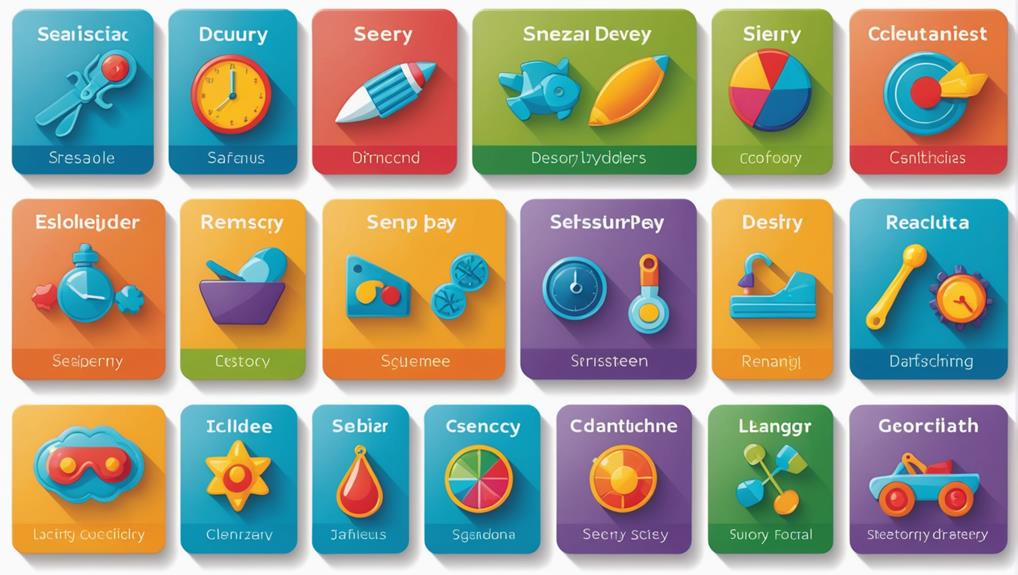Key Takeaways
- Identify sensory preferences and triggers in children with Sensory Processing Disorders for personalized diet planning.
- Collaborate with occupational therapists to design specific, engaging, and enjoyable sensory activities tailored to the child’s management of SPD symptoms effectively and implement a balanced schedule that incorporates alerting, organizing, and calming activities throughout the day.
- Regularly monitor and adjust the sensory diet based on behavioral changes, ensuring it remains effective and prevents overstimulation.
- Maintain consistency and patience in implementing the sensory diet, fostering a supportive and secure environment for the child.
A Simple Sensory Diet Diet
Contrary to what one might assume, a sensory schedule does not pertain to food but refers to a carefully tailored plan of sensory activities. It is a method crafted to meet the distinct sensory needs of individuals, especially those grappling with sensory processing disorders. These schedules are vital in managing conditions like Sensory Processing Disorder, which can lead to sensory oversensitivity and coordination challenges.
Sensory schedules incorporate a meticulously structured list of activities aimed at providing specific sensory input that supports arousal, focus, and organization. These activities, including tactile and proprioceptive inputs, are expertly chosen and scheduled by an Occupational Therapist to help regulate emotions, attention, and behavior effectively. The key to the effectiveness of a sensory schedule is its personalization, which takes into consideration an individual’s preferences and sensory thresholds.
The goal is to create a routine of sensory activities that can be seamlessly integrated into daily routines, offering a supportive environment that facilitates coping and flourishing despite sensory processing differences. Consistency and parental involvement play a pivotal role in enhancing behavior and overall functioning. At the core of a sensory schedule is the understanding that an individual’s needs are distinct and that ‘an ‘size-fits-all’ approach is both impractical and ineffective. By embracing a personalized sensory schedule, we enable individuals to manage their sensory experiences better, thus significantly improving their quality of life.
Identifying Sensory Processing Difficulties
Recognizing sensory processing challenges is the first step toward customizing an efficient sensory diet. Sensory processing issues in children can appear in diverse ways, often displaying behaviors that are easily misinterpreted. These can range from excessive physical movement and difficulty sleeping to being overly assertive during play. With the assistance of pediatric occupational therapists, these sensory challenges can be pinpointed accurately, paving the way for a focused and efficient sensory diet. Understanding these indications is vital for caregivers and professionals in developing and adjusting a sensory diet that effectively meets the child’s child’s requirements.
Some common signs of sensory processing challenges include:
- Impulsiveness: the child may act without forethought, often resulting in accidents or social blunders.
- Excessive wariness: the child may avoid novel experiences, limiting their potential to learn and develop.
- Difficulty adhering to instructions: The child may struggle to grasp or recall tasks, which can affect their academic performance and daily routines.
Understanding these indications and the issues linked to sensory processing challenges, such as working memory difficulties and sleep disturbances, guides us in customizing a sensory diet. Early intervention, as stressed in sensory integration therapy, can significantly assist in managing these challenges effectively. Keep in mind that each child is distinct. What is effective for one may not be effective for another. Hence, thorough observation and comprehension are crucial in this process.
Modifying Sensory Diets for Effectiveness

The effectiveness of a sensory diet can be significantly improved through careful adjustments customized to the specific requirements of a child with a sensory processing disorder. Integrating occupational therapy methods, like sensory integration therapy, can assist in addressing the sensory difficulties commonly linked with this condition. Essential factors to take into account involve the timing, strength, and variety of sensory activities chosen, alongside the incorporation of supplementary sensory programs. By monitoring and noting changes in behavior, caregivers can adapt the sensory diet to maximize self-regulation and comprehensive performance, ultimately enriching the child’s child experiences and engagements.
Sensory Diet Modifications
Adjusting the frequency, intensity, and duration of sensory activities is central to modifying a sensory diet for maximum efficiency. Sensory diet adjustments are tailored to meet personal needs, taking into account the child’s child’s sensory preferences and aversions. The strategic timing of activities, interwoven with daily tasks and play, is a powerful tool in this process. As part of this, creating an environment conducive to sensory experiences and engaging in tactile activities can help children process sensory information effectively.
Tracking behavior changes plays a crucial role in gauging the efficiency of the adjustments. By observing the child’s child’s sensory activities, parents and therapists can fine-tune the sensory diet, making necessary modifications to achieve desired outcomes. This ongoing monitoring can aid in promoting self-control, emotional management, and effective social interaction.
Key points to keep in mind when modifying sensory diets include:
- The incorporation of diverse sensory activities catering to a child’s child’s sensory needs
- Timing activities strategically to align with the natural rhythms of the child’s child ‘storing and tracking behavioral changes to evaluate the efficiency of the adjustments.
Additional sensory programs, such as the Alert program, M.O.R.E program, and Wilbarger Protocol, can be integrated into the sensory diet for improved efficiency. The goal is to create a sensory diet that fosters a sense of balance and well-being in the child, paving the way for optimal development and growth.
Sensory Activities Selection
Selecting suitable sensory activities is a crucial step toward optimizing the effectiveness of a sensory diet. This relies heavily on understanding a child’s needs and making necessary adjustments to meet them. It’s essential to keep in mind that children with sensory processing disorder may have sensory sensitivities and motor skill issues that can impact their daily activities. Therefore, the sensory diet should incorporate activities that provide the right balance of frequency, intensity, and duration based on the individual’s needs.
Sensory activities can range from physical activities to deep pressure squishing, tactile activities, and visual, oral, and auditory activities. The key lies in tailoring these activities to align with the child’s needs and preferences. Sensory strategies should also consider the timing of these activities throughout the day, ensuring they are seamlessly integrated into the child’s daily tasks.
To maximize the effectiveness of the sensory diet, professionals and caregivers can utilize additional sensory programs like the Alert program, M.O.R.E program, and Wilbarger Protocol. Keeping a record of behavior changes in response to sensory activities can also help refine the sensory diet, making it more effective over time. Much like strategies employed in managing SPD effectively, regular monitoring and adjustments are essential in ensuring the sensory diet continues to meet the child’s needs. Keep in mind that the aim is to create a sensory diet that improves a child’s child’s sensory experience, well-being, and development.
Importance of Sensory Balanced Schedules
Understanding the significance of sensory-balanced schedules is fundamental, especially for children with sensory processing disorders. These structured schedules, tailored to individual sensory needs, provide stability and consistency, which are essential for children grappling with sensory challenges.
Given that Sensory Processing Disorder (SPD) can affect all senses, creating daily routines that cater to a child’s child’s sensory profile becomes even more indispensable. A sensory diet isn’t without routine tasks. It is a therapeutic intervention designed to help children better manage their sensory experiences. These sensory-rich activities stimulate diverse sensory systems, enhancing regulation and well-being.
Crafting daily routines that effectively address the specific sensory needs of these children is pivotal. These routines promote a sense of security and comfort, especially during unforeseeable days, and provide a structured environment that helps manage SPD symptoms.
The key elements to remember while crafting these schedules include:
- Prioritizing sensory-rich activities that serve as therapeutic interventions.
- I am tailoring daily routines to suit the individual sensory needs of each child.
- We are ensuring predictability and structure to foster a sense of security.
Thus, sensory-balanced schedules play a critical role in optimally supporting children with sensory processing disorders, nurturing their growth, and enhancing their quality of life.
Components of a Sensory Balanced Schedule

Crafting a sensory-balanced schedule requires careful attention to distinct components that guarantee an effective sensory diet. These components are designed around the child’s needs and integrated into daily routines using sensory activities. A properly balanced schedule includes an array of whole-body, sensory-rich activities dispersed throughout the day.
The schedule includes a mix of alerting, organizing, and calming activities to help with sensory regulation. Alerting activities, called “red” activities, are meant to boost energy and burn off extra energy. Examples are bouncing on a ball chair or playing active games like Ninja Warrior.
Organizing activities, sometimes referred to as “green” “activities, help with focus and maintaining attention. These might include activities like cooking, which involves following steps or gently rocking in a chair.
Finally, calming activities, called “blue” activities, help reduce energy and encourage relaxation. Examples include sipping a smoothie through a straw or cuddling under a weighted blanket for comfort and calm.
When creating a sensory diet activity plan, consider these components to ensure a balanced approach. Remember, the ultimate goal is to meet the child’s child’s needs and improve their sensory processing abilities.
Exploring Different Sensory Systems
In an effort to create a thorough sensory diet for a child with a sensory processing disorder, one must consider the diverse sensory systems that play an essential role in a child’s childishness sensory systems, each with their distinct roles and functions form the backbone of a child’s child sent and interaction with the world. They include the visual, auditory, tactile, olfactory, and proprioceptive systems.
- The visual system is fundamental to a child’s development, balance, and safety. It interprets visual information to guide a child’s actions and responses.
- The auditory system aids in communication and environmental safety, with a primary role in conversations, listening, and interpreting sounds.
- The tactile system helps in understanding the environment, detecting danger, and locating objects through touch.
The olfactory system, associated with memory and emotions, plays a pivotal role in interpreting smells and sensing danger. Lastly, the proprioceptive system provides proprioceptive input, informing the brain about body movement and position and consequently enhancing body awareness. Understanding these systems is essential in creating effective sensory diets that cater to the specific needs of children with sensory processing disorders.
Understanding Sensory Preferences and Thresholds

As a child’s child’s world is shaped, their sensory preferences and thresholds emerge as significant aspects to consider. These sensory preferences can vary widely, including movement, proprioceptive input, tactile input, auditory input, tastes, and smells.
The sensory threshold is the point at which an individual responds to sensory stimuli. It’s crucial to meet this threshold when developing sensory diets, as this keeps the child engaged without causing overstimulation. Observing signs of overstimulation during sensory activities is essential, as exceeding the threshold can lead to adverse reactions.
Understanding and identifying a child’s child’s preferences is a critical step in tailoring sensory activities. By recognizing these preferences, one can craft a sensory diet that caters to the child’s child’s needs, promoting their development and well-being. This understanding also allows for the adjustment of activities to suit the child’s sensory needs, preventing overstimulation and fostering a positive sensory experience. This process, though intricate, is an essential task in serving children with sensory processing disorders. Patience, empathy, and expert knowledge will be your guiding lights on this path.
Building and Implementing Sensory Diets
Designing an effective sensory plan requires a deep understanding of the child’s child’s needs and preferences. A sensory plan is a tailored activity plan designed to meet the distinct sensory needs of children with sensory processing disorders. It involves a series of sensory activities and strategies to help the child self-regulate, manage behavior, and improve emotional awareness.
The key to a successful sensory plan lies in the details. It should be customized to be engaging and enjoyable to prevent refusal and promote participation. It should also consider factors such as frequency and intensity of sensory activities and include well-structured daily routines.
When building and implementing a sensory plan, remember to:
- Be consistent and patient, as changes may not be immediate.
- Ensure the sensory plan includes a variety of motivating and enjoyable activities.
- Regularly update the sensory plan to keep it fresh and compelling.
With these strategies, you can create an effective sensory plan that meets your child’s needs, encourages positive behavior, and improves their overall quality of life.
Resources and Support for Sensory Diets

Constructing a sensory diet is just the initial phase of the exploration. Success lies in consistently implementing crafted diets and using diverse sensory tools like weighted vests and blankets for effective regulation. Recognizing and respecting sensory-seeking behaviors can lead to improved behavior and mood regulation in children.
A plethora of resources are available to aid those dedicated to serving these children. Sensory diet creators are designed to assist in the creation of tailored sensory plans. Checklists can offer a structured approach to identifying the necessary sensory inputs. Quizzes provide an engaging and interactive way of understanding children’s sensory needs.
Furthermore, digital courses can provide thorough guidance on sensory diets. These online platforms often provide expert advice, case studies, and practical examples, which enhance the learner’s understanding.
Moreover, consulting with Occupational Therapists before implementing a sensory diet can provide expert guidance. They possess the knowledge to recommend suitable sensory tools and offer strategies for their practical use.
These resources not only support the creation and implementation of sensory diets but also promote a better understanding of sensory processing disorders, bringing us one step closer to enhancing the lives of impacted children.
Sensory Diet Overview
A sensory diet, an essential tool in managing sensory processing disorders, is a thoughtfully curated set of activities tailored to meet a person’s individual sensory needs. This plan aids in regulating emotions, attention, and behavior by providing the necessary sensory input. Understanding and implementing these personalized diets can significantly enhance the daily lives of those dealing with sensory processing issues.
Understanding Sensory Diets
While it may seem intricate, a sensory plan is fundamentally tailored sensory input specifically designed to improve focus and organization in individuals dealing with sensory processing disorders. It is a personalized sensory strategy that considers a child’s child’s needs, helping to regulate emotions, attention span, and changes. These plans deliver immediate and cumulative effects on the nervous system over time, playing an essential role in sensory development.
Sensory plans are designed in collaboration with an occupational therapist specializing in sensory processing. They are flexible and dynamic, with adjustments based on age, arousal level, and setting. Here are three key elements:
- Sensory Tools and Gear: These tools can provide the necessary sensory input and serve as an integral part of the sensory plan.
- Tools and Lists: They can help monitor progress and ensure that the sensory plan aligns with the child’s child’s needs.
- Surroundings: The environment plays a significant role in the effectiveness of a sensory plan. Modifications may be necessary to create a conducive environment for the child.
Implementing Individualized Diets
One of the most effective strategies for managing symptoms in the complex world of sensory processing disorders is implementing tailored sensory diets. Every child with sensory processing disorder has distinct needs and preferences, so the sensory diet activity should be tailored to meet these specific requirements.
The process of creating a sensory diet starts with identifying the child’s child’s preferences and triggers. This can be done efficiently with the help of an occupational therapist who specializes in sensory processing disorders. The expert can offer insights into the most suitable sensory inputs, ensuring the child receives a balanced sensory diet.
Once the sensory inputs are identified, daily routines should be established. Consistency in these routines is vital, as the effects of a sensory diet are both immediate and cumulative over time. It’s crucial to approach this task with patience and understanding, as it may take time for the child to adjust to the chosen sensory inputs.
Implementing personalized diets can significantly help regulate emotions, enhance attention span, and ease changes, thus providing a supportive environment for children with sensory processing disorders.
Creating a Personalized Sensory Diet

Understanding a child’s sensory challenges is paramount to creating a tailored sensory diet designed to meet the child’s needs and preferences. A sensory diet is a customized plan that includes a variety of sensory activities aimed at helping the child regulate their sensory input throughout the day. This personalized approach is shaped by the child’s processing issues, sensitivities, and sensory-seeking behaviors.
The ultimate goal of a customized sensory diet is to provide the right balance of sensory input that enables the child to stay focused, calm, and organized. Creating an effective sensory diet often involves collaboration with an occupational therapist specializing in sensory processing.
As you start creating a tailored sensory diet, consider these critical factors. I understand the child’s child’s sensory processing issues and sensitivities.
- We are identifying sensory-seeking behaviors that the child exhibits.
- We are collaborating with a specialized occupational therapist.
Proprioception Activities in Sensory Diets
Delving into the realm of proprioception activities in sensory diets, it becomes clear that these exercises play a crucial role in improving body awareness, coordination, and movement control for children with sensory processing disorders. These activities, which typically involve lifting, pushing, and pulling heavy objects, provide the necessary deep-pressure input that these children require to understand and navigate their physical world.
Engaging in proprioception activities, such as carrying weighted items, resisting exercises, or even receiving firm massages, can significantly enhance a child’s child’s attention. By providing a steady stream of proprioceptive input, these activities help regulate arousal levels, allowing the child to feel more grounded, organized, and calm throughout the day.
Incorporating proprioception activities into a child’s routine is not just beneficial but crucial. These exercises foster an increased sense of body awareness, improving movement control and coordination skills. With regular practice, children with sensory processing disorders can gain a better understanding of their bodies, ultimately leading to enhanced self-regulation and a vital quality of life.
Successful Sensory Diet Tips and Strategies

While every child with a sensory processing disorder is distinct, it’s crucial to consider individual sensory needs and preferences when creating a sensory diet. A successful sensory diet hinges on tailoring alerting, organizing, and calming activities to suit the child’s child’s sensory profile.
Strategies for creating an effective sensory diet include:
- Incorporating a variety of alerting, organizing, and calming activities throughout the day. This might involve sensory play, focused tasks, or relaxation techniques.
- Monitor and adjust the sensory diet regularly based on the child’s child’s behavior. This guarantees that the sensory diet remains responsive to the child’s child’s needs.
- I am seeking guidance from professionals like occupational therapists who can provide expert advice on developing a sensory diet plan.
Frequently Asked Questions
Where is the best place to set up a sensory area at home to help create sensory diets?
Choose a quiet, low-traffic area where your child feels safe and comfortable. This space should include tools and activities tailored to their needs, making it ideal for supporting sensory activities in their daily routine.
What to Feed a Child With Sensory Processing Disorder?
For children with sensory processing disorder, a wide-ranging diet encompassing differing textures, temperatures, colors, and flavors is advised. Integrate foods requiring different chewing levels and present visually appealing meals for a thorough sensory experience.
What Is a Sensory Diet for Sensory Processing Disorder?
A sensory diet is a tailored regimen of sensory activities designed to assist children with sensory processing disorders in achieving balance and calm while enhancing skills such as concentration and behavior through specific sensory stimulation.
How Often Should I Eat a Sensory Diet?
A sensory die isn’t something you eat like; it’s a personalized activity plan designed to provide the sensory input a child needs to stay balanced and regulated. The term “diet” refers to the variety and timing of these activities, similar to how a well-balanced food diet supports physical health. To be most effective, a sensory diet should be used consistently throughout the day, with activities integrated into daily routines like playtime, homework, or transitions between tasks.
Which Three Types of Activities Typically Are Included in a Sensory Diet?
A sensory diet typically incorporates three types of activities: alerting (red), organizing (green), and calming (blue). These activities aim to balance arousal, promote attention, and regulate sensory input throughout the day respectively.


Recent Comments